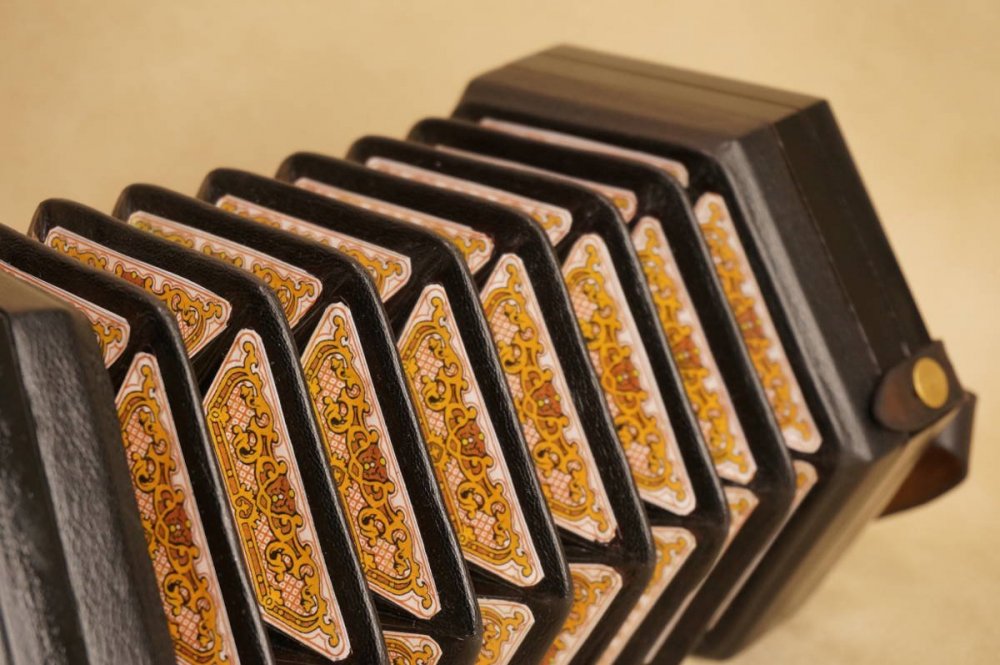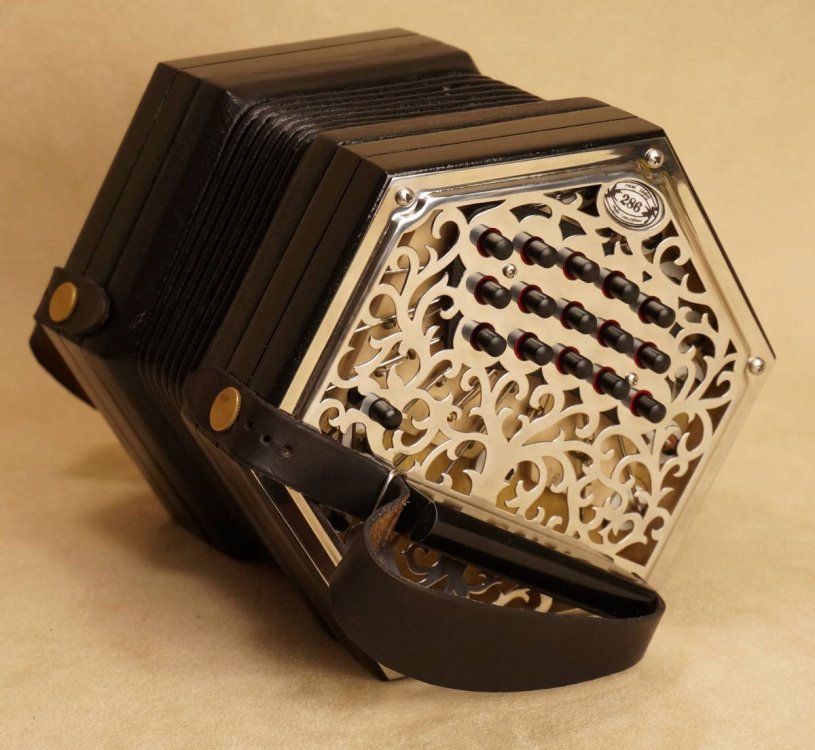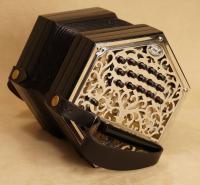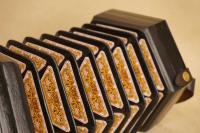-
Posts
45 -
Joined
-
Last visited
About CZ in AZ
- Birthday 05/29/1962
Contact Methods
-
Website URL
http://dancetosteam.com
Profile Information
-
Gender
Female
-
Interests
You mean besides concertina ??? I play bodhrán and other percussion, sing and clog in contradance band, STEAM, and in duo, Púca. I am also a long time contradance caller and a Walnut Valley Festival, Carp Camp regular! I work at the University of Arizona as the Director of Pima County Cooperative Extension.
-
Location
Tucson, Arizona
Recent Profile Visitors
The recent visitors block is disabled and is not being shown to other users.
CZ in AZ's Achievements

Advanced Member (3/6)
-
Hi all, Thank you for your thoughtful replies. To me, a player needs to communicate the rhythm and lift of the tune, by using ornaments and held or punched notes to both accomodate the intrument and enhance the tune's lift and drive. I agree with Edel Fox's comment "ornaments that are sparse but precise". I also do not necessarily think meeting the needs of the dancers is the final word on pace and I would say that most people can play faster in a session, where they are supported by a bigger group. I suggest that playing reels competantly at 100 bpm and jigs at 115 BPM would be a good milepost for considering that you could comfortably take an advanced class. Most recordings may be faster than that, but most people recording are pushing the tops of their ability and they are also generally more expert than those of us taking lessons. Other milestones might be the ability to add ornaments without any hesitation and spontaneously, being able to play variations or to key in alternative ways on the fly, and to pick up quickly by ear to suite the faster pace of an advanced lesson. I meet these criteria, so technically, I think I could manage in either one, but which one would help my playing the most? Truthfully, this probably depends on the individual teachers methods and tune choices. So, beyond our own abilities and whether we qualify, what do we get in an advanced or intermediate workshop? Of course this will vary with each teacher, but probably both advanced and intermediate will include some element of repertoire and style. Personally, I am fascinated by better bellows control, fingering choices that increase the rhythm, and I love learning tunes that are accessible enough that I can master them and introduce to my local players. I want to know the teacher's fingering and ornament choices and to follow those in the class, even if I do not always stay with them in the long run. I am also practical - I don't particularly care to labor over a tune that has been transposed into a key for easy concertina playing even though nobody plays it in that key at sessions. So from our collective experiences, do we get these things in both intermediate and advanced workshops? Love hearing your thoughts Claire
-
CZ in AZ changed their profile photo
-
I received the following when I inquired about what level workshop to attend. "If you can play jigs and reels at a good pace, with embellishments... then consider yourself as advanced." Emphasis is mine. It made me think about what exactly a "good pace" is and what qualifies as "embelishments" I play anglo and in this case I am talking about Irish music. I am really curious how others would define good pace with embellishments, and in what context, ie in a session, playing alone, playing with a single rhythm player. Interested to see what you think.
-
Hi all..... I have been researching this and building on David M.'s post in the previous thread. After learning more about sound waves and how they propagate, here is my summary explanation. Enjoy! String instruments resonate in a chamber, so their near volume is a sum of coalescing, reflecting, and circulating sound waves, some of which translate into propagating far-field waves. These larger sound-producing units (violins, guitars, bass, etc.) behave as extended sources, and thus produce more near-field power relative to their far-field signal. A small free-reed emits waves more like a perfect point-like source, and the output radiates into the far-field, like a pure dipole source. Although the concertina and accordion do have overtones and do not create a perfect sine wave, the overtones are produced from the reed, not by resonating in a chamber. Likewise, other far-carrying instruments, banjo, and fife, are more like a point-source, penetrating cleanly into the far-field. When close to a sound-emitting object, the sound waves behave in a much more complex fashion, and there is no fixed relationship between pressure and distance. Very close to the source, the sound energy circulates back and forth with the vibrating surface of the source, never escaping or propagating away. These are sometimes called “evanescent” waves. As we move out away from the source, some of the sound continues to circulate, and some propagates away from the object. This transition from circulating to propagating continues in an unpredictable fashion until we reach the threshold distance of 2 wavelengths, where the sound field strictly propagates (the far-field.) This mix of circulating and propagating waves means that there is no fixed relationship between distance and sound pressure in the near field, and making measurements with a single microphone can be troublesome and unrepeatable. Typically, measuring in the near field requires the use of more than one microphone in order to accurately capture the energy borne by the circulating and propagating waves. Note that the wavelengths involved are in this range: lowest note on a bass (E) = 27 feet; lowest note on a guitar (E) =13.5 feet; lowest note on fiddle (G) = 5.6 feet; middle C = 4 feet; and 440 A = 2.5 feet. So in a jam, everyone is in the near field regime for those that are close to them, but it depends on the note and the volume of the instrument whether you are in the near-field for those sitting across the jam, particularly if the circle is more than 8-10 feet across. If you are outside the jam, more like 20 feet, you are still within the near-field for the bass, but probably not for other instruments.... for them, you are just hearing the sound that is making it into the far-field. The directionality of the instrument does not make a difference in the far-field, but it can strongly affect the near-field.
-
Hey everyone - particularly those versed in the physics of sound. I play in a lot of music jams, some of which are outside in festival settings. On occasion, I have been told by those walking nearby, that all they can hear is the concertina until they get close enough that the fiddles, banjos, guitars, bass, etc fills in the sound. Inside the jam, the concertina is pretty well balanced with the other instruments and no complaints. I experienced this myself at a recent festival where I heard a cajun accordion playing, and as I weaved my way through the cars and RVs to get to it, I started to hear all the other instruments. I assume this is the same phenomenon. At some sessions, particularly if it is a large room, the concertina seems louder in comparison to the other instruments the farther you get from the musicians. Why is this? One of my friends suggested that the string instruments depend on a resonating chamber to make the sound. As a result, the sound is more diffuse at its origin and therefore attenuates more quickly. In contrast, a reed instrument has air pushed through a very small opening and thus the sound is actually more concentrated at its source and travels farther. Another person suggested that reeds produce fewer overtones. The clear central tone travels farther, but it is not necessarily louder to players that are right next to you. I don't know enough about the physics of sound to know why this happens, but I sure would like a simple explanation. Has anyone else experienced this and do you know why it happens? Looking forward to hearing about your ideas and experiences! Claire
-
Hi all, I decided to keep the Edgley for a few more years. Does anyone else head out from work at lunch to play concertina? I do and this is my lunch concertina It really is such a lovely instrument. All the best, Claire
-
Hi BMD, Yes, I could sell it. Please email me to discuss this further. clairezu247@gmail.com. Thanks! Claire
-
Yes it is. I have a potential buyer locally and she is using it this week. If you are interested, I should be able to get an answer back from her in a week or so. Claire
-
Thanks to all for your thoughtful replies. It is helpful to hear your ideas. I go to the doctor tomorrow and hopefully will move a bit farther toward figuring this out. I am not sure what movement I am making with my pinky other than just playing, but I do think it is related to playing tunes that feature a lot of fingering on the low end of the instrument. As I study my playing, I also think that I lack control in my pinky and ring finger and so tend to pounce (snap down) on the buttons rather than gently depress them. I am working on that aspect. I have an ongoing issue with being too far from the buttons, in general, so it is probably related to that. Yet another thing to think about. It is probably not helpful that I type at work and then practice more than an hour at home most days. I will keep you posted, Claire
-
Yes it is!
-
Hi all, I play a C/G anglo and many of the tunes I enjoy are active in the lower part of the left hand. My pinky, on the left, has been getting progressively more sore over the past 6 months and while I am pretty sure it is some sort of repetitive stress, I am not sure what to do about it. FYI, I regularly stretch the pinky and hand, but this does not seem to affect the aching or progressive nature of the symptoms. The main symptom is that it is very stiff, i.e. when I bend the finger it feels like the tendons/muscles are having to stretch and it does not loosen much after playing. Also, the middle joint is sore and somewhat enlarged (swollen?). This has become somewhat chronic so that it aches much of the time and more when I type - not good! Perhaps I should go to a hand specialist or physical therapy or take glucosamine or ibuprofen? More or different stretching? I have tried playing with my pinky more bent rather than semi-straight, but that does not seem to help and it needs to be somewhat straight to reach the A/B button on the inside row. Any thoughts or suggestions would be most welcome. Thank you! Claire
-
For Sale: Edgley C/G concertina - great condition. Asking price $2100 (not including shipping). It has a modified Jeffries layout, 30 button, with C#s on the draw and press top inside right button and also on the press on the next button. It is in great condition and was fully refurbished by the button box about 4 years ago. It has not been played very much in the last couple of years because I have another instrument. It is a hybrid model, meaning that it is a high-quality concertinas made using Italian accordion-style reeds. The sound is really lovely and it plays very easily - no bellows leaks at all. It is number 286 as you can see in the pictures. It comes with a hard case, which was originally for another concertina. FYI, I am located in the western U.S. Thanks, Claire
-
Dear all, The most amazing thing happened - my concertina was returned! I want you to know that this listserve is the way that the person found me, so if this happens to you, I highly recommend posting on this site. Thank you for all your support! Claire
-
It is a professional model (hybrid). The serial number is 286. Thank you so much for keeping an eye out for it. I have no idea if it will re-surface or not, but one can always hope. I am so pained by the thought that it is in the garbage somewhere. I think I will call all the Phoenix music stores next. I tried the local pawn shops as well, but no luck. It is really nice just to know you all are out there on the look. Claire
-
Hi everyone, I am very sad to report that my Edgley C/G concertina has been stolen. I have filed a police report and called all the local Tucson shops. I am checking ebay regularly, but is there anything else I can do? This was my spare concertina, since I got my Carrol, so I did not play it all that frequently, but I still loved it and am really really sad about it. If you see this instrument, please let me know? It was a Wheatstone layout, modified to have C#'s as followed (rt outside row) Push/Pull: C#/C# C#/D# G#/G high-C#/high-D# high-A/high-F Thank you for any ideas on how to look for it! Claire (520)-869-8553, clairezu247@gmail.com
-
I have been taking from Flo over skype for a couple of years and she is great. I also took a lesson from her in person when I had only been playing a month - and she was really a good teacher for both levels. She definitely teaches the Irish style. She is clear in her instruction and has an amazing ear, even over skype, to catch little stylistic bad habits. If you are looking to eventually include ornaments, octave playing, chords, etc, she will definitely get you off on the right foot. Best of luck and have a blast!







